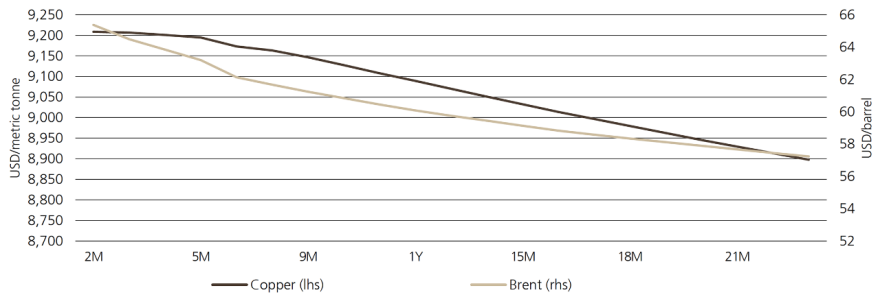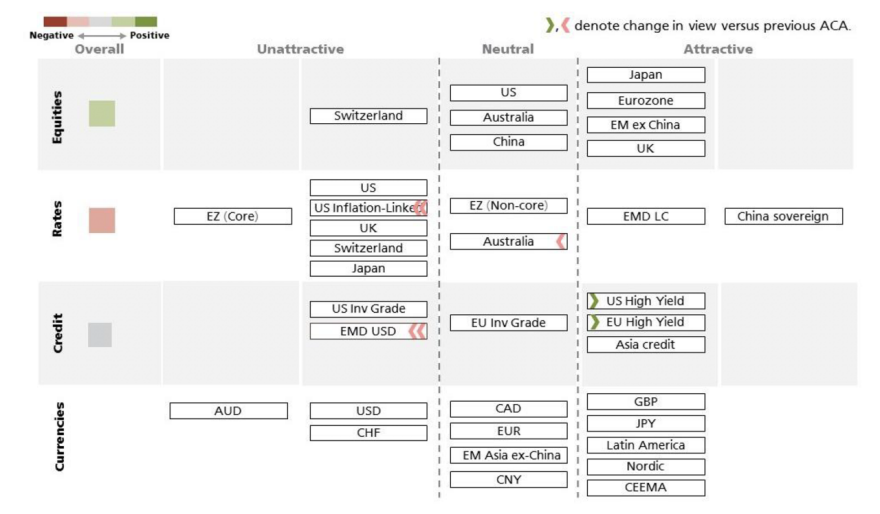
UBS AM: Key macro curves confirm more procyclical strength
We believe that we have found ample evidence to support our risk-on, procyclical bias and optimism on the global economic recovery.
09.03.2021 | 08:15 Uhr
Highlights
- Procyclical positioning continues to work across markets. As multi-asset investors, we look across the investable universe for confirmation that the broad macro and market backdrop remains supportive.
- Three market-based curves stand out to us as confirming that there is more room to run: a steepening yield curve, backwardated commodities curve, and overly cautious VIX futures curve support our positioning.
- After a slow start, a steeper 'vaccination curve' indicates progress towards normalization accelerating.
- We continue to watch these curves, along with other economic and market indicators, for evidence that the backdrop is shifting or already priced in. As this happens, we plan to shift positioning accordingly.
Our preferred risk-on, procyclical stance is being well rewarded in financial markets so far this year. Along the way, it’s become a more widely shared consensus – and perhaps crowded – view. Complacency does not beget consistent success, and so the popularity of the early-cycle playbook demands that we reevaluate whether these positions are fully valued or can continue to outperform.
As multi-asset investors, we scrutinize the investable universe for signals that confirm or challenge our base case. In examining three important market-based curves and another relating to public health outcomes, we believe that we have found ample evidence to support our risk-on, procyclical bias and optimism on the global economic recovery. We will monitor the evolution of these curves to determine if and when the macroeconomic sands are shifting, and are prepared to adjust our positioning accordingly.
Shot in the arm
After a slow start, global vaccinations are picking up steam. In successfully navigating production, distribution, and administration challenges, inoculation campaigns are laying the foundation for a durable, comprehensive economic reopening and broad-based earnings growth.
This is the cornerstone of the reflation thesis. An acceleration in vaccinations bolsters visibility on the timing of the service sector recovery, and lessens the risk of additional economic scarring tied to prolonged mobility restrictions. In the US, the pace of administering vaccination doses roughly tripled in the second month relative to the first.
Progress on vaccinations also varies widely between different countries, which provides a potential catalyst for relative value trades. The UK, in particular, is a standout among major economies in terms of getting shots in arms. This outperformance informs our constructive view on the British pound and UK equities, among our most preferred in each asset class. We believe that both are relatively undervalued, and should benefit from inflows amid the ebbing of the Brexit uncertainty overhang as well as a more expedient services sector recovery.
We believe this trend steepening of vaccination curves can continue and broaden across advanced economies as production increases and the approvals of additional candidates make doses less scarce. Mutations of the virus are a risk to the outlook, but vaccines appear to be reasonably effective in preventing severe illnesses from these variants. This should alleviate pressure on hospitalizations on a going-forward basis and allow for a loosening of mobility restrictions.
Exhibit 1: Acceleration in vaccinations is laying the foundation for a durable reopening

Source: UBS Asset Management, Goldman Sachs. Data as of 23 February 2021.
Activity normalizing, central banks aren’t
Economic optimism unlocked by the development of effective vaccines and enhanced by the promising outlook for continued US fiscal stimulus is being more fully reflected in global bond markets.
In early 2021, the bond sell-off was most concentrated in US Treasuries, but has more recently become more widely shared across advanced economies. The global backup in yields suggests a common catalyst, which we believe to be an increased conviction in a vigorous synchronized upswing across developed economies in the coming quarters, facilitated by successful vaccination campaigns. That global yield curves are steepening points to an expectation that central banks will remain accommodative for an extended period of time to allow the pandemic-induced economic damage to be repaired. That credit markets are holding up fairly well amid this brisk rise in yields suggests that the bond sell-off is primarily a good-news message about the outlook for activity and inflation.
Fed officials, including Chair Jerome Powell, have yet to push back against the rise in longer-term yields. On the contrary, Powell seemingly welcomed this development as a sign that investors have confidence the US will have a robust, complete recovery. European Central Bank president Christine Lagarde, for her part, has displayed more concern on the potential for this backup in yields to adversely affect the nascent recovery on the continent.
Some of the bond market sell-off in the US relates to pulling forward expectations on Federal Reserve interest rate hikes. An aggressive extension of this trend, and accompanying rise in real yields and US dollar, could serve as a trigger for more disruption in equity markets as well as credit. We have seen some signs of this in the recent performance of high-duration growth stocks. Ultimately, we believe the Fed will overpower any overzealousness on the pricing of liftoff that tightens financial conditions or contradicts its forward guidance, as discussed in the February edition of Macro Monthly, The market will test the Fed. The Fed will win.
We remain short global duration, expecting further upwards pressure
on yields across developed-market sovereign debt. The gap between two-
and 10-year Treasury yields should continue to widen, in our view, as
the Federal Reserve commits to holding off on rate hikes for the time
being while longer-term borrowing costs reflect the discounting of a
future in which it will eventually do so after dual mandate goals are
achieved. As such, the message sent from the bond market affirms that we
are poised to embark upon a period of strong economic growth during
which procyclical positions should disproportionately benefit.
Exhibit 2: Long term bonds sell off on enhanced conviction in an eventual return to normal

Source: UBS-AM, Bloomberg. Data as of 24 February 2021
Bullish backwardation
Many commodity futures curves, such as crude oil and copper, are in a downward-sloping term structure known as backwardation.
Near-term contracts being priced higher than longer-dated futures is indicative of a market in which demand is outstripping supply. Accordingly, both crude and copper have posted robust gains in 2021. The advance in oil is attributable to both continued supply discipline from OPEC+ and an anticipated resurgence in demand. The crude curve thus reinforces the message from the vaccination curve – mobility will improve, and so too will demand for gasoline and, with a lag, jet fuel. The copper curve suggests that markets share our belief that any pullback in Chinese stimulus will not be abrupt, and that goods sectors will continue to perform well amid a rotation to services-led growth as vaccinations allow for progress towards pre-pandemic norms.
Tightening physical commodity markets are generally positive signals for cyclicals over defensives, emerging market currencies against the dollar, and negative for sovereign bonds. Backwardation also means that long commodity positions can generate positive roll yield over time, which can help increase the attractiveness of commodities as an asset class.
Exhibit 3: Term structure of commodity futures suggests physical market tightening

Source: UBS-AM, Bloomberg. Data as of 23 February 2021.
Future fears are your friend
Mix together high hedge fund equity exposure, retail exuberance, expensive valuations, and a near universally positive outlook for economic activity, and investors can reasonably wonder whether the biggest thing to fear about the equity market is the lack of fear itself. However, futures tied to the VIX Index – a gauge of the implied volatility for the S&P 500 Index based on out-of-the-money options prices that’s often called Wall Street’s “fear gauge” – paint a more nuanced picture on this front.
The VIX curve is generally in an upward-sloping structure called contango (the opposite of backwardation) for two reasons: Uncertainty about the outlook increases as a function of time, and US stocks are not typically in the kind of sharp drawdown that would have short-term measures of implied volatility trading above their longer-term counterparts.
At this time, the front of the VIX futures curve is an especially steep contango, ranging from 1 to 2.5 standard deviations above the 10-year mean throughout the first three weeks of February1. This suggests the curve is pricing a pronounced pick-up in market volatility in the not-too-distant future. In addition, longer-dated contracts trade at a significant premium to their historical averages. This is in part due to a continued imbalance in volatility markets, where supply continues to be constrained following the intense 2020 bear market.
This term structure sends a strong signal that complacency does not reign in US equities. We do not believe this persistent medium-term skittishness is warranted given the fundamentals. Elevated levels of market volatility are unlikely
to prevail for an extended period if our anticipated backdrop of a broad acceleration in economic activity and colossal earnings growth comes to pass. A compression in this fear premium could provide an additional tailwind for stocks in the months ahead.
1 Based on 10Y weekly VIX front versus second month futures spread, 2011 through Feb 28, 2021.
Exhibit 4: VIX futures curve suggests elevated concern on the outlook for equities

Source: UBS-AM, Bloomberg. Data as of 23 February 2021.
Conclusion
Vaccinations are the necessary prerequisite for a sustainable economic recovery. The commodities rally, and shape of those futures curves, point to the substantial rebound in demand and expectations for more to come. The steepening of yield curves speaks to the combined monetary-fiscal support that is underwriting the nascent expansion until it reaches a much more mature phase. And the term structure of VIX futures suggest additional risk premium lingers in equity markets which could dissipate over time and buoy equities in the process.
These key macro curves are all pointing in the right direction. While
these fortify our stance that there is more upside in global equities,
we are even more enthusiastic about the relative value positions beneath
the surface in stocks. For procyclical trades that are performing well
lately – value stocks vs. growth, US equal weight relative to market cap
indexes, and international equities vs. the US – there is considerably
more room to run.
But we are cognizant that this bright, early-cycle
backdrop will not persist in perpetuity. We will closely monitor shifts
in these curves, along with other economic and market indicators, to
judge whether the macroeconomic environment is changing or the
procyclical rebound is fully priced into different asset classes.
At present, the widespread cross-asset corroboration for our constructive stance on global equities and negative view on sovereign bonds bolsters our confidence in sticking with what is working.
Asset class attractiveness
The chart below shows the views of our Asset Allocation team on overall asset class attractiveness, as well as the relative attractiveness within equities, fixed income and currencies, as of 25 February 2021.

Source: UBS Asset Management Investment Solutions Macro Asset Allocation Strategy team as at 25 February 2021. Views, provided on the basis of a 3-12 month investment horizon, are not necessarily reflective of actual portfolio positioning and are subject to change.




Diesen Beitrag teilen: